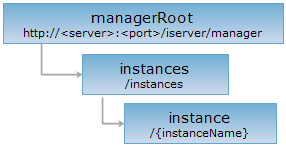URI
<instances_uri>/{serviceName}[.<format>]
Supported methods
Parent resource
Introduction
The service instance resource. Service instance configuration information, such as service components, component sets, service interfaces corresponding to the instance can be acquired through the instance resource.
Supported Methods:
- GET: Gets the configuration information of the service instance.
- HEAD: Checks whether the instance resource exists or whether it has permission to access the resource.
Supported output formats: rjson, json, html, xml.
Resource hierarchy

HTTP request methods
Implement the HTTP request on the following URI, where supermapiserver is the server name, {scname} is the service component name, {siname} is the service interface name, and the service instance name {serviceName} is composed of {scname} and {siname}. The result will be presented in rjson format.
http://supermapiserver:8090/iserver/manager/instances/{scname}/{siname}.rjson
GET request
Gets the configuration information of the service instance.
Response structure
The returned resource representation structure is as follows after implementing the GET request on the instance resource (resource representation is in the entity body of the response message):
| Field | Type | Description |
| authorizeSetting | AuthorizeSetting | The authorization setting. |
| componentName | String | Name of the consumed service component. |
| componentSetName | String | Name of the consumed service component set. |
| componentType | String | Name of the consumed service component. |
| enabled | boolean | Whether the current service instance is usable. The default is true, indicating usable. |
| id | String | ID of the service instance. |
| interfaceName | String | Name of the consumed service interface. |
| interfaceType | String | Type of the consumed service interface. |
| name | String | Name of the current service instance. |
| Status | String | The service status information, the value can be INITIALIZING, OK or FAILED, indicating service is being initialized, service has been started successfully, or service failed to start respectively. While the value of enabled is false, the value of state is DISABLED. |
Response example
Suppose we implement the GET request on the service instance http://localhost:8090/iserver/manager/instances/map-china400/rest.rjson, the returned representation in rjson format for the map-china400/rest service instance is as follows:
{
"authorizeSetting": {
"deniedRoles": [],
"permittedRoles": [],
"type": "PUBLIC"
},
"componentName": "map-china400",
"componentSetName": null,
"componentType": "com.supermap.services.components.impl.MapImpl",
"enabled": true,
"id": null,
"interfaceName": "rest",
"interfaceType": null,
"name": "map-china400/rest",
"status": "OK"
}
HEAD request
Asks for the response identical to the one that would correspond to a GET request, but without the response body. This is useful for retrieving meta-information written in response headers, without having to transport the entire content. The meta-information includes the media-type, content-encoding, transfer-encoding, content-length, etc.
HEAD request can be used to check if the instance resource exists, or if the instance resource can be accessed by clients. It can also determine if the instance resource supports an output format <format> if performed on a URI with .<format> included.